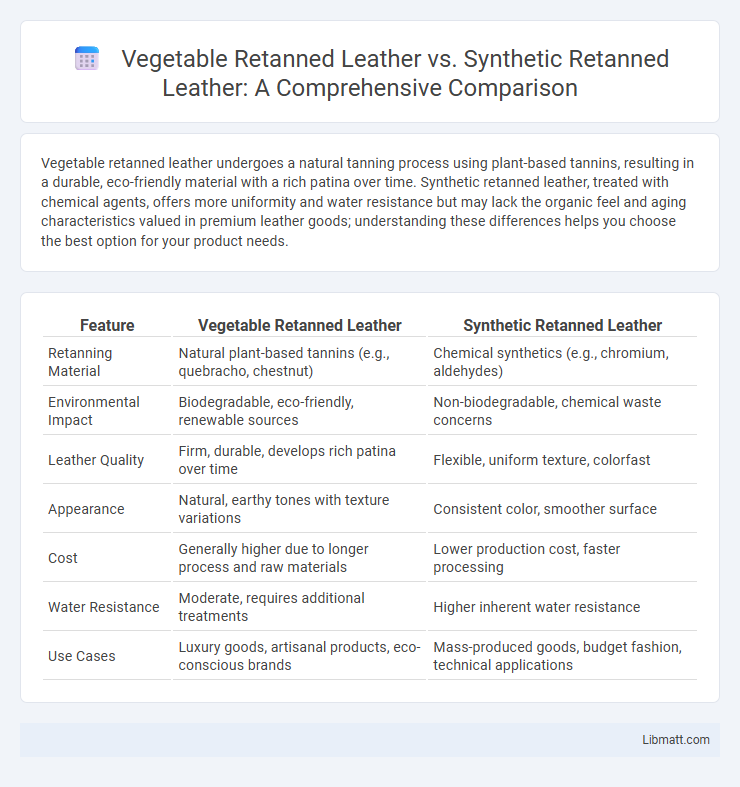Vegetable retanned leather undergoes a natural tanning process using plant-based tannins, resulting in a durable, eco-friendly material with a rich patina over time. Synthetic retanned leather, treated with chemical agents, offers more uniformity and water resistance but may lack the organic feel and aging characteristics valued in premium leather goods; understanding these differences helps you choose the best option for your product needs.
Table of Comparison
| Feature | Vegetable Retanned Leather | Synthetic Retanned Leather |
|---|---|---|
| Retanning Material | Natural plant-based tannins (e.g., quebracho, chestnut) | Chemical synthetics (e.g., chromium, aldehydes) |
| Environmental Impact | Biodegradable, eco-friendly, renewable sources | Non-biodegradable, chemical waste concerns |
| Leather Quality | Firm, durable, develops rich patina over time | Flexible, uniform texture, colorfast |
| Appearance | Natural, earthy tones with texture variations | Consistent color, smoother surface |
| Cost | Generally higher due to longer process and raw materials | Lower production cost, faster processing |
| Water Resistance | Moderate, requires additional treatments | Higher inherent water resistance |
| Use Cases | Luxury goods, artisanal products, eco-conscious brands | Mass-produced goods, budget fashion, technical applications |
Introduction: Understanding Retanned Leather
Vegetable retanned leather undergoes a natural tanning process using plant-based tannins that enhance durability and develop a rich, unique patina over time. Synthetic retanned leather uses chemical compounds to achieve more uniform texture and color, often improving water resistance and reducing production time. Your choice between these types impacts the leather's environmental footprint, aging qualities, and overall performance in finished products.
What is Vegetable Retanned Leather?
Vegetable retanned leather is tanned using natural tannins extracted from plant sources such as tree bark, leaves, and fruits, imparting durability and a rich, deep color that develops character over time. This eco-friendly process results in leather that is biodegradable, breathable, and often sought after for high-quality, artisanal products. In contrast to synthetic retanned leather, which relies on chemical agents for tanning, vegetable retanned leather offers superior environmental sustainability and a unique aesthetic appeal.
What is Synthetic Retanned Leather?
Synthetic retanned leather is a type of leather treated using chemical agents like synthetic resins and polymers to enhance its durability, texture, and appearance. Unlike vegetable retanned leather, which uses natural tannins from tree bark and plants, synthetic retanning provides more consistent results and faster production times. This process improves water resistance, flexibility, and color uniformity, making synthetic retanned leather ideal for mass-produced goods.
Environmental Impact Comparison
Vegetable retanned leather uses natural tannins from plant sources, resulting in a biodegradable and less toxic process with lower environmental pollutants compared to synthetic retanned leather, which relies on chemical agents derived from petroleum products. Synthetic retanned leather often involves heavy metals and hazardous substances that contribute to soil and water contamination, while vegetable retanning reduces reliance on non-renewable resources and produces more eco-friendly waste. Choosing vegetable retanned leather supports sustainable practices and minimizes your environmental footprint by promoting a cleaner, renewable tanning method.
Durability and Longevity
Vegetable retanned leather offers superior durability due to its natural tanning process, which strengthens the collagen fibers and provides excellent resistance to wear and tear over time. Synthetic retanned leather, often made from polyurethane or PVC, tends to degrade faster with exposure to heat and UV light, leading to cracking and peeling. The longevity of vegetable retanned leather typically surpasses that of synthetic variants, making it a preferred choice for long-lasting leather goods.
Aesthetics and Aging Process
Vegetable retanned leather showcases a rich, natural patina that deepens and develops character over time, enhancing its unique aesthetic appeal with subtle color variations and texture changes. Synthetic retanned leather tends to maintain a more uniform appearance, resisting aging signs like scratches or color shifts but lacking the dynamic visual transformation that natural materials provide. Your choice between these leathers impacts the longevity and evolving beauty of the product, favoring vegetable retanned options for a more authentic, aged look.
Cost Analysis
Vegetable retanned leather typically incurs higher production costs due to the extensive time and natural tannins used in processing, resulting in a premium price point compared to synthetic retanned leather. Synthetic retanned leather leverages chemical processes and mass production techniques, offering a more cost-effective option without the natural aging characteristics of vegetable tanned hides. Choosing your leather depends on budget constraints and the desired balance between cost-efficiency and traditional quality attributes.
Health and Safety Considerations
Vegetable retanned leather, crafted using natural tannins from tree bark and plants, poses fewer chemical risks and is less likely to cause skin irritation or allergic reactions compared to synthetic retanned leather, which often contains formaldehyde and other potentially toxic substances. Prolonged exposure to synthetic retanned leather's chemical residues can lead to respiratory issues and environmental pollution, raising health and safety concerns for both manufacturers and users. Choosing vegetable retanned leather supports safer indoor air quality and reduces harmful environmental impacts linked to synthetic tanning chemicals.
Applications and Popular Uses
Vegetable retanned leather is widely used in high-end products such as luxury handbags, wallets, belts, and footwear due to its durability, natural finish, and eco-friendly tanning process. Synthetic retanned leather, favored for its cost-effectiveness and consistency, is commonly applied in mass-produced footwear, upholstery, automotive interiors, and fashion accessories. The unique characteristics of vegetable retanned leather make it ideal for artisanal crafts and products emphasizing sustainability, while synthetic variants cater to industries requiring versatile and uniform material properties.
Choosing the Right Retanned Leather for You
Vegetable retanned leather offers a natural, eco-friendly option characterized by durability, rich patina development, and breathability, making it ideal for high-quality leather goods. Synthetic retanned leather provides consistent texture, water resistance, and cost-effectiveness, suitable for budget-conscious or mass-produced products. Evaluating your priorities such as environmental impact, longevity, and maintenance will help you select the most fitting retanned leather type for your needs.
Vegetable retanned leather vs synthetic retanned leather Infographic

 libmatt.com
libmatt.com